
Budget Plan - Annexes

|
|
|
Annexes 2 & 3 |
| - Franšais - Table of Contents - | |
There are three basic measures of the federal government’s fiscal position – two are based on the Public Accounts (the budgetary balance and financial requirements/surplus) and one on the System of National Accounts, as prepared by Statistics Canada.
Differences in the measures arise because the accounting frameworks are designed for different purposes.
The fundamental purpose of the Public Accounts is to provide information to Parliament on the Government’s financial activities as required under the Financial Administration Act. The Public Accounts are based on generally accepted accounting principles for the public sector (as recommended by the Public Sector Accounting and Auditing Board) and are audited by the Auditor General of Canada.
The financial requirements/surplus, excluding exchange fund transactions, measures the difference between cash payments by the Government and cash receipts. It is roughly equivalent to the amount of money that the Government has to borrow in credit markets or the amount of market debt that the Government is repaying. However, in any one year, changes in the Government’s cash balance and foreign reserve position can also have an effect on the level of market debt.
In essence, the budgetary balance includes obligations incurred by the federal government during the course of the year, whereas the financial requirements/surplus includes only the actual cash outlay related to these obligations.
The main difference to date between the budgetary balance and the financial requirements/surplus is the treatment of federal government employees’ pension accounts. The budgetary balance includes the total annual pension-related obligations (the Government’s contribution as an employer for current service costs plus interest on its borrowings from the pension accounts) while the financial requirements/surplus includes only the benefits paid out in that year less employee premiums paid. In 1998-99, the federal employees’ pension funds accounted for $5.0 billion of the $8.6 billion difference between the budgetary balance and financial requirements/surplus.1
Most industrialized countries present their budgets on a basis that is more comparable to the financial requirements/surplus than to the Public Accounts measure of the budgetary balance. The financial requirements/surplus corresponds closely to the Unified Budget Balance in the United States.
The primary objective of the National Accounts is to measure current economic production and income. The government sector in the National Accounts is treated on the same basis as other sectors of the economy. As such, only tax revenues collected on income generated in the current year are included as revenues, and only spending which relates to economic activity in the current year is included as expenditures. The current National Accounts and the financial requirements/surplus treat the transactions of federal government employees’ pension accounts similarly.
The budgetary balance (deficit or surplus) is the most comprehensive of the three measures. It includes all financial transactions between the Government and outside parties. It also includes liabilities incurred during the year for which no cash payment has been made.
Each of the three measures provides important complementary perspectives on the Government’s fiscal position. Although the measures differ in their levels, their trends are broadly similar (Chart A2.1 and Table A2.1).
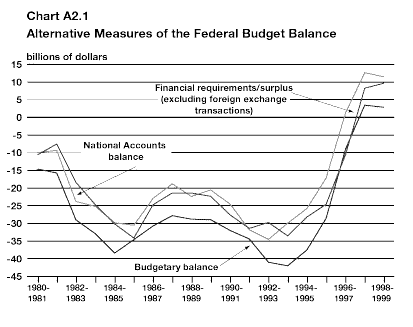
Table A2.1
Alternative Measures of the Federal Budget Balance1
| Fiscal year | Budgetary balance | Financial requirements/surplus (excluding foreign exchange transactions) | National Accounts balance2 | |||
|---|---|---|---|---|---|---|
| Millions of dollars | Per cent of GDP | Millions of dollars | Per cent of GDP | Millions of dollars | Per cent of GDP | |
| 1980-81 | -14,556 | -4.6 | -9,917 | -3.1 | -10,631 | -3.4 |
| 1981-82 | -15,674 | -4.3 | -9,264 | -2.6 | -7,516 | -2.1 |
| 1982-83 | -29,049 | -7.6 | -23,819 | -6.3 | -18,448 | -4.9 |
| 1983-84 | -32,877 | -8.0 | -25,219 | -6.1 | -24,664 | -6.0 |
| 1984-85 | -38,437 | -8.6 | -29,824 | -6.6 | -30,092 | -6.7 |
| 1985-86 | -34,595 | -7.1 | -30,510 | -6.3 | -34,068 | -7.0 |
| 1986-87 | -30,742 | -6.0 | -22,918 | -4.5 | -24,721 | -4.8 |
| 1987-88 | -27,794 | -5.0 | -18,849 | -3.4 | -21,422 | -3.8 |
| 1988-89 | -28,773 | -4.7 | -22,424 | -3.7 | -21,360 | -3.5 |
| 1989-90 | -28,930 | -4.4 | -20,530 | -3.1 | -22,266 | -3.4 |
| 1990-91 | -32,000 | -4.7 | -24,538 | -3.6 | -27,605 | -4.1 |
| 1991-92 | -34,357 | -5.0 | -31,800 | -4.7 | -31,391 | -4.6 |
| 1992-93 | -41,021 | -5.9 | -34,497 | -4.9 | -29,709 | -4.3 |
| 1993-94 | -42,012 | -5.8 | -29,850 | -4.1 | -33,451 | -4.6 |
| 1994-95 | -37,462 | -4.9 | -25,842 | -3.4 | -28,241 | -3.7 |
| 1995-96 | -28,617 | -3.5 | -17,183 | -2.1 | -24,649 | -3.1 |
| 1996-97 | -8,897 | -1.1 | 1,265 | 0.2 | -10,535 | -1.3 |
| 1997-98 | 3,478 | 0.4 | 12,729 | 1.5 | 8,347 | 1.0 |
| 1998-99 | 2,884 | 0.3 | 11,491 | 1.3 | 9,658 | 1.1 |
| 1 A
positive number denotes a surplus, a negative number denotes a deficit. 2 National Accounts balance figures are on a calendar-year basis. |
||||||
As the deficits or surpluses derived from these three measures are different, so are the measures of debt (Table A2.2).
Table A2.2
Alternative Measures of the Federal Debt
| Fiscal year | Net debt | Interest-bearing debt | Market debt | National Accounts debt1 | ||||
|---|---|---|---|---|---|---|---|---|
| Millions of dollars | Per cent of GDP | Millions of dollars | Per cent of GDP | Millions of dollars | Per cent of GDP | Millions of dollars | Per cent of GDP | |
| 1980-81 | 91,948 | 29.2 | 112,418 | 35.7 | 83,138 | 26.4 | 49,380 | 15.7 |
| 1981-82 | 107,622 | 29.9 | 126,684 | 35.1 | 93,167 | 25.8 | 59,359 | 16.5 |
| 1982-83 | 136,672 | 36.0 | 154,221 | 40.6 | 116,562 | 30.7 | 79,789 | 21.0 |
| 1983-84 | 169,549 | 41.2 | 184,849 | 45.0 | 142,901 | 34.8 | 109,753 | 26.7 |
| 1984-85 | 207,986 | 46.3 | 219,458 | 48.8 | 172,719 | 38.4 | 142,565 | 31.7 |
| 1985-86 | 242,581 | 50.0 | 253,381 | 52.2 | 201,229 | 41.5 | 173,838 | 35.8 |
| 1986-87 | 273,323 | 53.4 | 286,034 | 55.9 | 228,611 | 44.7 | 200,769 | 39.2 |
| 1987-88 | 301,117 | 54.0 | 313,948 | 56.3 | 250,809 | 44.9 | 219,013 | 39.2 |
| 1988-89 | 329,890 | 53.9 | 345,057 | 56.4 | 276,301 | 45.2 | 239,306 | 39.1 |
| 1989-90 | 358,820 | 54.7 | 370,104 | 56.4 | 294,562 | 44.9 | 266,781 | 40.7 |
| 1990-91 | 390,820 | 57.6 | 406,475 | 59.9 | 323,903 | 47.8 | 293,756 | 43.3 |
| 1991-92 | 425,177 | 62.2 | 440,181 | 64.4 | 351,885 | 51.5 | 324,416 | 47.5 |
| 1992-93 | 466,198 | 66.7 | 477,034 | 68.3 | 382,741 | 54.8 | 363,123 | 52.0 |
| 1993-94 | 508,210 | 70.1 | 514,510 | 71.0 | 413,975 | 57.1 | 395,539 | 54.6 |
| 1994-95 | 545,672 | 71.1 | 550,192 | 71.7 | 440,998 | 57.5 | 424,372 | 55.3 |
| 1995-96 | 574,289 | 71.2 | 586,387 | 72.7 | 469,547 | 58.2 | 455,786 | 56.5 |
| 1996-97 | 583,186 | 69.9 | 600,557 | 72.0 | 476,852 | 57.2 | 458,817 | 55.0 |
| 1997-98 | 579,708 | 66.3 | 594,825 | 68.1 | 467,291 | 53.5 | 450,002 | 51.5 |
| 1998-99 | 576,824 | 64.4 | 594,985 | 66.4 | 460,427 | 51.4 | 433,168 | 48.4 |
| 1 National
Accounts debt figures represent net financial assets on a calendar-year basis. Note: Numbers may not add due to rounding. |
||||||||
This annex provides a brief overview of the fiscal performance of the federal, provincial and territorial governments. In assessing fiscal performance, the evolution of budget balances, net debt, debt servicing costs, revenues, program spending and operating balances, on a Public Accounts basis, are all taken into consideration.
Recent years have witnessed a significant restoration of the fiscal health of the federal-provincial-territorial government sector in Canada. This sector’s deficit of $66 billion in 1992-93 was completely eliminated by 1998-99. In that year, the federal surplus of $2.9 billion offset the deficit of $1.9 billion at the provincial-territorial level.
Six provinces and territories are expecting a balanced budget or surplus in 1999-2000, compared to seven in 1998-99 (Chart A3.1). Recent accounting changes in Nova Scotia and New Brunswick have led to a deterioration in their budgetary balances.
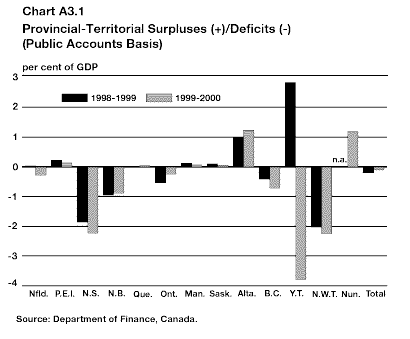
Largely because of the better-than-projected results through the first half of 1999-2000 in Ontario and Alberta, fiscal improvement in the overall provincial-territorial sector is expected to continue in 1999-2000. Robust economic growth and high energy prices are leading to significant growth in provincial-territorial revenues. As a result of these factors and continued fiscal discipline, the provincial-territorial deficit is expected to fall to $1.1 billion in 1999-2000, the seventh consecutive yearly decline (Chart A3.2). This represents the lowest provincial-territorial deficit in over 20 years.
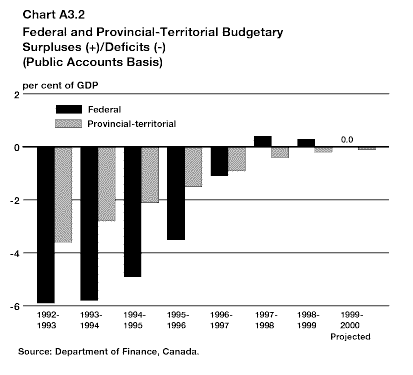
The federal government is committed to a balanced budget or better for 1999-2000. As a result, the federal-provincial-territorial government sector is expected to post at most a small deficit in 1999-2000.
Moreover, based on the latest budget plans, the provincial-territorial deficit should continue to decline in the medium term, as all provinces and territories are committed to balanced budgets. In addition, the federal government remains committed to a balanced budget or better in both 2000-01 and 2001-02. As a result, the federal-provincial-territorial government sector should record balanced budgets or better in each of the next two fiscal years.
After peaking in 1995-96 at 98.6 per cent of GDP, the federal-provincial-territorial net debt-to-GDP ratio is projected to fall to 88.7 per cent of GDP in 1999-2000 (Chart A3.3). The improvement in overall fiscal balances, coupled with sustained GDP growth, has enabled both the federal and provincial-territorial governments to reduce their debt burdens in recent years.
The federal debt burden is projected to decline to about 61.1 per cent of GDP in 1999-2000 from its peak of 71.2 per cent of GDP in 1995-96. Through the Debt Repayment Plan and continued economic growth, the Government is committed to ensuring that the debt-to-GDP ratio remains on a sustained downward path.
The provincial-territorial debt burden, which has been declining since 1997-98, is estimated at 27.6 per cent of GDP in 1999-2000.
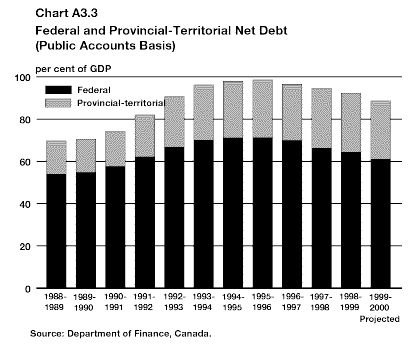
Primarily because of deficit elimination, federal debt charges as a share of total revenues have declined rapidly since 1995-96 and are expected to fall to 26.0 per cent of revenues in 1999-2000 from a peak of 36.0 per cent in 1995-96. In contrast, given a much lower debt burden, provincial-territorial debt charges as a share of total revenues have declined only marginally since 1995-96 and are expected to fall to 13.1 per cent of revenues in 1999-2000 from a peak of 13.9 per cent in 1995-96 (Chart A3.4).
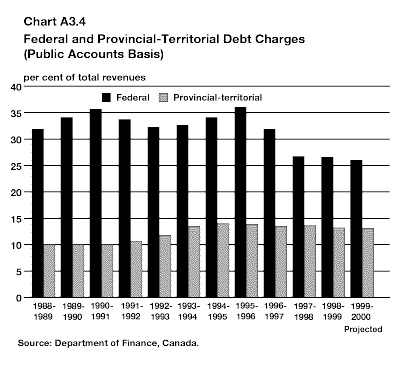
Although total revenues for both levels of government continue to grow, they currently represent a similar share of GDP to what they were at the end of the 1980s (Chart A3.5).
Federal revenues as a share of GDP dropped significantly following the 1990-1991 recession. However, with the ensuing growth of the economy and a progressive tax system, federal revenues rose steadily until 1997-98. Since 1997-98, this ratio has begun to decline again – this time as a result of the tax reduction measures implemented in the 1998 and 1999 budgets.
Provincial-territorial revenues, however, have remained more stable over the last 10 years. In 1999-2000, they are expected to decline slightly as a share of GDP, reflecting recent provincial tax cuts.
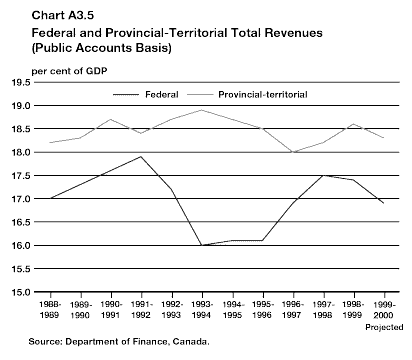
Program spending as a percentage of GDP for both levels of government will continue its downward trend in 1999-2000, reflecting robust economic growth and continued fiscal discipline (Chart A3.6).
Federal program spending is expected to fall to 12.2 per cent of GDP in 1999-2000, the lowest level since 1949-50. This represents a 5.3-percentage-point drop from its peak in 1992-93. Likewise, provincial-territorial program spending is expected to decline to 16.0 per cent of GDP in 1999-2000, down from 20.1 per cent in 1992-93.
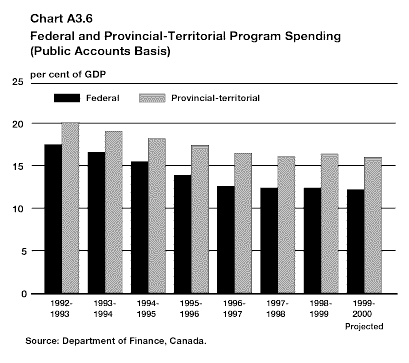
Fiscal consolidation strategies pushed operating balances, defined as the difference between total budgetary revenues and program spending, from a deficit in 1993-94 to a significant surplus by 1998-99.
The federal government, which recorded an operating deficit of 0.3 per cent of GDP in 1992-93, is expected to record an operating surplus of 4.7 per cent of GDP in 1999-2000. The provincial-territorial sector, which recorded an operating deficit of 1.4 per cent of GDP in 1992-93, is expected to record an operating surplus of 2.3 per cent of GDP in 1999-2000 (Chart A3.7).
The trends shown in Charts A3.5 and A3.6 indicate that the federal and provincial-territorial governments achieved their operating balance improvements primarily through expenditure cuts.
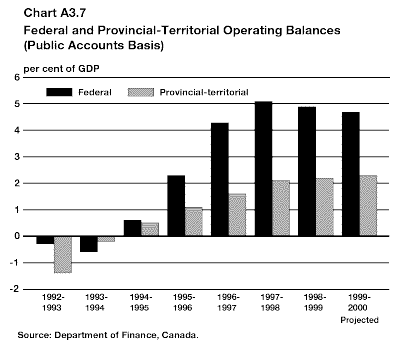
1 The recent legislated reform of the federal employee pension plans will significantly narrow this difference in the future. Effective April 1, 2000, contributions to the plans will be invested in the market, thereby reducing the difference between the budgetary balance and financial requirements/surplus by about $3.5 billion.
| Budget 2000 Publications | Budget 2000 Main Page |